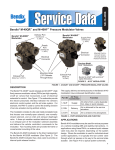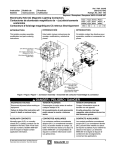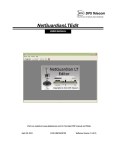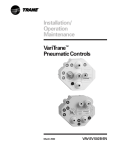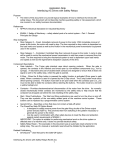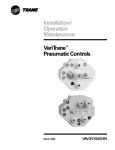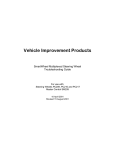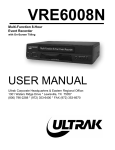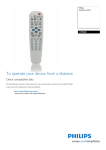Download BENDIX BW1669 User's Manual
Transcript
SD-13-4772 ® Bendix® M-12™ & M-12R™ AntiLock Modulator 4 PIN CONNECTOR SUPPLY PORT DELIVERY PORTS 2 VERTICAL 2 HORIZONTAL CONTROL PORT COVER PLATE DELIVERY PORTS 4 VERTICAL SUPPLY PORT WIRE HARNESS CONTROL PORT 3 PIN CONNECTOR M-12™ Modulator M-12R™ Modulator FIGURE 1 M-12™ AND M-12R™ MODULATORS DESCRIPTION The M-12™ antilock modulator is a standard component in Bendix antilock systems. It is comprised of two components: solenoids, which rapidly apply and exhaust air during an antilock stop, and a standard relay valve. During normal, non-antilock operation, the M-12™ modulator serves as a relay valve that speeds the application and release of the service brakes. If wheel lock up is impending, a antilock controller commands the solenoids to modulate brake chamber pressure on the axle(s) on which the system is installed. The M-12™ modulator is offered in two configurations as illustrated in figure 1. The M-12™ modulator permits direct attachment of an antilock controller, and it accepts electronic commands from the controller through a four pin connector (see Figure 1). The M-12R™ modulator is designed for remote mounting on a vehicle frame rail or cross member. It accepts electronic commands from a remote mounted controller through a wire harness assembly that has a four pin connector at one end and a three pin connector at the other (see Figure 1). The M-12™ modulator and M-12R™ modulator differ from each other only in that the M-12™ modulator is designed for direct controller mounting while the M-12R™ modulator uses a cover plate where the controller would normally mount and a wire harness is attached to the M-12R™ modulator in order to connect it to the antilock controller. Two body styles are available; one with four vertical delivery ports and another with two vertical and two horizontal delivery ports. The M-12™/M-12R™ modulator is normally mounted close to the service actuators it serves, and it can be nipple mounted to a reservoir or secured to the frame rail. The M-12™ modulator air connections are as follows: M-12™/M-12R™ Modulator Air Connection Supply (to reservoir) Delivery (to brake actuator) (can have 2 horizontal & 2 vertical deliveries or 4 vertical deliveries) Control (to rear service brake valve delivery) Embossed Identification SUP DEL CON The standard M-12™ and M-12R™ modulator is offered with a 4 psi crack pressure. The internal components are interchangeable with R-12™ and R-14™ relay valves therefore, the same maintenance kit is used to service all. 1 SERIAL LINK DASH LAMP RELAY SPRING BRAKES SERVICE BRAKE RETARDER DISABLE IN-AXLE WHEEL SPEED SENSOR M-21™/M-22™ MODULATOR BRAKE VALVE STOP LIGHT SWITCH WS-20™ WHEEL SPEED SENSOR NOTCHED HUB EXCITER M-12™ MODULATOR WITH ANTILOCK CONTROLLER MOUNTED REAR AXLE (S) FRONT AXLE FIGURE 2A FULL VEHICLE AXLE CONTROL - TRUCK/TRACTOR NOTCHED HUB EXCITER SPRING BRAKES WS-20™ WHEEL SPEED SENSOR M-12R™ MODULATOR SR-5™ TRAILER SPRING BRAKE VALVE REMOTE MOUNT ANTILOCK CONTROLLER FIGURE 2B TANDEM SPREAD AXLE TRAILER - AXLE CONTROL SYSTEM 2 DOUBLE CHECK TRAILER CONTROL EXHAUST SOLENOID BRAKE VALVE CONTROL SUPPLY SOLENOID PISTON RESERVOIR DELIVERY SUPPLY EXHAUST SERVICE BRAKE CHAMBER FIGURE 3 APPLYING: NORMAL SERVICE APPLICATION Figure 2 shows two antilock systems in which the M-12™ and M-12R™ modulator can be used. Figure 2A is a typical schematic for a full vehicle axle control system, and Figure 2B is a typical trailer installation using the M-12R ™ modulator. With the attachment of different controllers, the M-12™ or M-12R™ modulator can adapt to either system. OPERATION APPLYING: NORMAL SERVICE APPLICATION When a normal service brake application is made, and the antilock wheel sensors do not sense impending wheel lock up, service air pressure enters the modulator control port. Air passes through the normally-open supply solenoid and into the relay valve portion of the modulator. (The normallyclosed exhaust solenoid remains closed.) Air acts on the relay piston closing the exhaust and opening the inlet. Supply air pressure flows to the delivery ports and out to the service brake chambers. BALANCED POSITION: NORMAL SERVICE APPLICATION The relay valve portion of the modulator reaches a balanced position when service delivery pressure acting on the underside of the relay piston approaches that of the control air acting on the top side of the piston. The piston moves allowing the inlet valve to close, while the exhaust remains closed. This prevents the valve from delivering or exhausting air. EXHAUSTING: NORMAL SERVICE APPLICATION When a service application is released, air at the modulator control port returns to the application valve. Control pressure above the relay piston exhausts through the supply solenoid and the check valve in the solenoid housing out to the exhaust port of the valve that sent the control signal. Relay piston movement opens the modulator's exhaust, allowing air from the piston's underside (and from the service brake chambers) to exhaust through the modulator exhaust port. ANTILOCK MODE: SOLENOIDS ACTIVATED If a service application is made and the antilock controller senses impending wheel lockup, it commands the M-12™/ M-12R™ modulator to modify the service brake application pressure. When activated by the controller, the M-12™/ M-12R™ modulator solenoids alter application by exhausting and applying control air pressure above the relay piston. The supply solenoid closes, preventing control line pressure from entering the modulator. Then the exhaust solenoid opens, allowing control pressure to exhaust from the top side of the piston through the exhaust port of the solenoid assembly. This activity occurs in a pulsating manner, simulating "pumping the brakes." 3 DOUBLE CHECK EXHAUST SOLENOID TRAILER CONTROL BRAKE VALVE CONTROL SUPPLY SOLENOID PISTON RESERVOIR DELIVERY SUPPLY EXHAUST SERVICE BRAKE CHAMBER FIGURE 4 BALANCED POSITION PREVENTIVE MAINTENANCE Important: Review the warranty policy before performing any intrusive maintenance procedures. An extended warranty may be voided if intrusive maintenance is performed during this period. 2. Inspect all air lines connected to the M-12™/M-12R™ modulator for signs of wear or physical damage. Replace as necessary. 3. Test air line fittings for excessive leakage and tighten or replace as necessary. Because no two vehicles operate under identical conditions, maintenance intervals will vary. Experience is a valuable guide in determining the best maintenance interval for a vehicle. OPERATIONAL AND LEAKAGE TEST GENERAL 1. Apply and release the brakes several times and check for prompt application and release at each wheel. If the response at the wheels is "sluggish," check for a kinked or obstructed air line leading to or from the M-12™/ M-12R™ modulator. Perform the following tests and inspections at the prescribed intervals. If the M-12™/M-12R™ modulator fails to function as described, or if leakage is excessive, repair the valve or obtain a replacement from any authorized Bendix parts outlet. EVERY THREE MONTHS, 25,000 MILES, 900 OPERATING HOURS, OR DURING THE VEHICLE CHASSIS LUBRICATION INTERVAL, MAKE THE VISUAL INSPECTIONS IN THE SERVICE CHECKS EVERY YEAR, 100,000 MILES, OR 3,600 OPERATING HOURS, PERFORM THE OPERATIONAL AND LEAKAGE TESTS SERVICE CHECKS 1. Remove any contaminants and visually inspect the valve's exterior for excessive corrosion or physical damage. 4 OPERATIONAL TEST 2. Road test the vehicle to determine proper modulator operation. The system can be tested by making an aggressive stop from a vehicle speed of 20 mph. When an aggressive stop is made, solenoid pulsation creates an audible burst of air, which can be heard from outside the vehicle. LEAKAGE TEST 1. Build air system pressure to governor cut out. With the service brakes fully applied, coat the exhaust port with a soap solution. A 1" bubble in 3 seconds is permitted. Coat the outside of the modulator body to check for seal ring leakage. No leakage is permitted. DOUBLE CHECK TRAILER CONTROL EXHAUST SOLENOID BRAKE VALVE CONTROL SUPPLY SOLENOID PISTON RESERVOIR DELIVERY SUPPLY SERVICE BRAKE CHAMBER EXHAUST FIGURE 6 ANTILOCK MODE: SOLENOIDS ACTIVATED 2. With the service brakes released, coat the exhaust port and the area around the retaining ring with a soap solution. A 1" bubble in 3 seconds is permitted. 3. If leakage is excessive around the supply and exhaust solenoids, replace the M-12™/M-12R™ modulator. If excessive leakage is detected where the solenoid assembly and body meet, replace the M-12™/M-12R™ modulator. If excessive leakage is detected at the exhaust port, before replacing the M-12™/M-12R™ modulator, perform the following test. Place the vehicle in park by exhausting the air pressure from the emergency side of the spring brake. Perform the leakage check. ELECTRICAL TESTS 1. Before testing the solenoid assembly of a "suspect" modulator, its location on the vehicle should be confirmed using the Trouble Shooting or Start-Up procedure for the specific antilock controller in use. (See the Service Data Sheet for the antilock controller for this procedure.) 2. Proceed to the modulator in question and identify it as an M-12™ or M-12R™ modulator and inspect its wiring connector. In the case of an M-12™ modulator it will be necessary to remove the four cap screws that secure the controller to the modulator. The M-12R™ modulator has an external connector that can be tested without removing the cover. Disconnect the connector and test the resistance between the pins on the modulator. Refer to figure 7. For the FOUR pin connector test as follows A. Black to Black: Read 9 to 12 OHMS B. White to White: Read 9 to 12 OHMS For the THREE pin connector on the M-12R test as follows A. Red to Black: Read 9 to 12 OHMS B. Red to White: Read 9 to 12 OHMS Note: If the resistance readings for the three pin connector are NOT as shown, the wire harness leading to the to the under side of the modulator cover may require repair or replacement. Remove the cover (as discussed elsewhere in this manual) and disconnect the four pin connector and perform the tests shown for the FOUR pin connector. If the resistance is correct at the four pin connector the short wire harness between the four and three pin connectors is at fault. 3. If the resistance values are NOT AS SHOWN, replace the modulator. WARNING! PLEASE READ AND FOLLOW THESE INSTRUCTIONS TO AVOID PERSONAL INJURY OR DEATH: When working on or around a vehicle, the following general precautions should be observed at all times. 1. Park the vehicle on a level surface, apply the parking brakes, and always block the wheels. Always wear safety glasses. 5 DOUBLE CHECK EXHAUST SOLENOID TRAILER CONTROL BRAKE VALVE CONTROL SUPPLY SOLENOID PISTON RESERVOIR DELIVERY SUPPLY EXHAUST SERVICE BRAKE CHAMBER FIGURE 6 ANTILOCK MODE: SOLENOIDS ACTIVATED 2. Stop the engine and remove ignition key when working under or around the vehicle. When working in the engine compartment, the engine should be shut off and the ignition key should be removed. Where circumstances require that the engine be in operation, EXTREME CAUTION should be used to prevent personal injury resulting from contact with moving, rotating, leaking, heated or electrically charged components. 3. Do not attempt to install, remove, disassemble or assemble a component until you have read and thoroughly understand the recommended procedures. Use only the proper tools and observe all precautions pertaining to use of those tools. 4. If the work is being performed on the vehicle’s air brake system, or any auxiliary pressurized air systems, make certain to drain the air pressure from all reservoirs before beginning ANY work on the vehicle. If the vehicle is equipped with an AD-IS™ air dryer system or a dryer reservoir module, be sure to drain the purge reservoir. 5. Following the vehicle manufacturer’s recommended procedures, deactivate the electrical system in a manner that safely removes all electrical power from the vehicle. 6. Never exceed manufacturer’s recommended pressures. 7. Never connect or disconnect a hose or line containing pressure; it may whip. Never remove a component or plug unless you are certain all system pressure has been depleted. 6 8. Use only genuine Bendix ® replacement parts, components and kits. Replacement hardware, tubing, hose, fittings, etc. must be of equivalent size, type and strength as original equipment and be designed specifically for such applications and systems. 9. Components with stripped threads or damaged parts should be replaced rather than repaired. Do not attempt repairs requiring machining or welding unless specifically stated and approved by the vehicle and component manufacturer. 10. Prior to returning the vehicle to service, make certain all components and systems are restored to their proper operating condition. MODULATOR REMOVAL 1. Identify, mark, or label all air lines and wiring cables and their respective connections on the modulator (M-12R™) or modulator/controller assembly (M-12™). 2. Disconnect all air lines and wiring. 3. Remove the modulator (M-12R™) or modulator/controller assembly (M-12™) from the vehicle. MODULATOR INSTALLATION 1. Install all air line fittings and plugs. Make certain no thread sealing material enters the modulator. 2. Install the assembled modulator (M-12R™) or modulator/ controller assembly (M-12™) on the vehicle. FOUR PIN CONNECTOR SHORT WIRE HARNESS BETWEEN THREE AND FOUR PIN CONNECTOR (M-12R™ MODULATOR ONLY) THREE PIN CONNECTOR TYPICAL M-12™ MODULATOR TYPICAL M-12R™ MODULATOR EXHAUST HOLD Black White WHITE BLACK COMMON SHORT WIRE HARNESS USED ON THE M-12R™ MODULATOR FIGURE 7 M-12™/M-12R™ MODULATOR CONNECTORS & WIRE HARNESS 3. Reconnect all air lines and wiring cables to the modulator or modulator/controller assembly using the identification made in MODULATOR REMOVAL, step 1. 4. Test all air fittings for excessive leakage and tighten as necessary. DISASSEMBLY - REFER TO FIGURE 8 The following disassembly and assembly procedure is presented for reference purposes only. A complete disassembly and assembly is described in detail, and it is assumed that the appropriate maintenance kit(s) is on hand. Several replacement parts and maintenance kits are available which do not require full disassembly. The instructions provided with these parts and kits should be followed in place of the instructions presented here. CAUTION: The M-12™/M-12R™ may be lightly clamped in a bench vise during disassembly. However, over clamping will result in damage, leakage, and/or malfunction. If a vise is to be used, position the M-12™/M-12R™ so the jaws bear on the flat area of the supply port and its opposing side of the body. 1. Remove all air fittings and plugs from the valve. 2. Mark the relationship of the electronic controller and solenoid assembly to the body. Note: Only the M-12™ modulator will have a controller installed directly on the solenoid assembly. The M-12R™ modulator will only have a cover plate enclosing the solenoid assembly. If a mounting bracket was used, mark the position of the bracket on the unit. 3. Remove and retain the four cap screws that hold the controller (M-12™ modulator) or cover plate (M-12R™ modulator) to the solenoid assembly. Then carefully lift the controller or cover plate from the solenoid assembly(3). The controller will be attached to the modulator by a four pin connector. Press the lock tab on the side of the connector and pull the connector from its socket in the controller. Now separate the controller or cover plate from the modulator. Remove the gasket(1) that seals the controller or cover plate to the solenoid assembly(3). Remove the four cap screws(2) that secure the solenoid assembly(3) to the valve body(7). Separate the solenoid assembly from the valve body, and remove sealing ring(4) from the protrusion on the bottom of the solenoid assembly. 4. Remove retaining ring(14), then remove the exhaust assembly(13). Remove o-ring(11) and o-ring(12) from the O.D. and l.D., respectively, of the exhaust assembly(13). 5. Remove spring(10) and inlet/exhaust assembly(8). Remove the spring seat(9) from the inlet exhaust assembly. 7 CAP SCREW (4) CAP SCREW (4) ANTILOCK CONTROLLER USED ON M-12™ MODULATOR COVER PLATE USED ON THE M-12R™ MODULATOR 1 1 2 3 4 5 6 7 8 9 10 11 12 13 14 FIGURE 8 M-12™/M-12R™ MODULATOR COMPONENTS 8 6. Using thumb force on the piston stem, push the piston(6) out the opposite end of the body(7). Remove o-ring(5) from the piston. 5. Depress the exhaust assembly into the bore until it exposes the groove for snap ring(14). Install snap ring(14) into its groove. Make sure it is fully seated. 7. Discard all items that have replacement parts in the maintenance kit. 6. Install o-ring(5) into its groove in piston(6). Install piston(6) into the M-12 body. The piston stem fits into the small hole in the center of the body. CLEANING & INSPECTION 1. Using mineral spirits or an equivalent solvent, clean and thoroughly dry all parts. Do not allow mineral spirits to come into contact with the wiring connectors or solenoids. 2. Inspect the interior and exterior of all parts that will be reused for severe corrosion, pitting or cracks. Superficial corrosion and/or pitting on the exterior portion of the body is acceptable. 3. Inspect bores for deep scuffing or gouges. 4. Inspect pipe threads in the body. Make certain they are clean and free of thread sealant. 5. Inspect all air line fittings and plugs for corrosion. Clean all old thread sealant from pipe threads. 6. Any component exhibiting a condition described in inspection steps 2 to 5 should be discarded and replaced before proceeding. ASSEMBLY - REFER TO FIGURE 8 1. Using a lubricant (Bendix Pc. No. 291126) lightly coat all o-rings, seals, pistons, and body bores. 2. Install spring seat(9) onto inlet exhaust valve(8) so that it covers the rubber seat of the inlet exhaust valve. Place inlet/exhaust valve, large diameter first, into the body(7) bore. 3. Install spring(10) over the barrel of the inlet exhaust valve(8) so that one end of the spring rests on the spring seat(9). 7. Install o-ring(4) onto the protrusion on the bottom of the solenoid assembly(3). Install the solenoid assembly(3) onto the body(7). The solenoid assembly will fit on the body(7) in any of four orientations, 90 degrees apart however it should be installed in the position marked in step 2 of the Disassembly instructions. Secure the solenoid assembly to the body with the four cap screws(2). Torque to 120 to 150 in. lbs. 8. Install gasket(1) onto the controller or cover plate. A. If installing a controller, connect the four pin connector on the solenoid assembly(3) to the corresponding connector on the controller making certain the connector halves snap and lock. B. If installing a cover plate, make certain the “pinch” grommet on the short wire harness is in one of the two “notches” in the solenoid assembly(3) so that when the cover plate is installed the wire harness will not be pinched. Note the relationship mark made in step 2 of the disassembly, then secure the controller or cover plate to the solenoid assembly(3) using the four cap screws. Torque to 30 60 in. lbs. 9. Install all air line fittings and plugs. Make certain no thread sealing material enters the valve. 10. Install the antilock assembly on the vehicle. Perform the "OPERATIONAL AND LEAKAGE TESTS" before returning the vehicle to service. 4. Install o-rings(11 and 12) into the respective grooves of the outside and inside diameter of the exhaust assembly(13). Place the large diameter of the exhaust assembly against the spring(10) and compress the spring until the exhaust assembly enters the bore of the body(7) and o-ring(11) seals against the wall of the bore. Make certain not to cut or pinch the o-ring. 9 10 11 12 BW1669 © 2004 Bendix Commercial Vehicle Systems LLC. All rights reserved. 4/2004 Printed in U.S.A.












